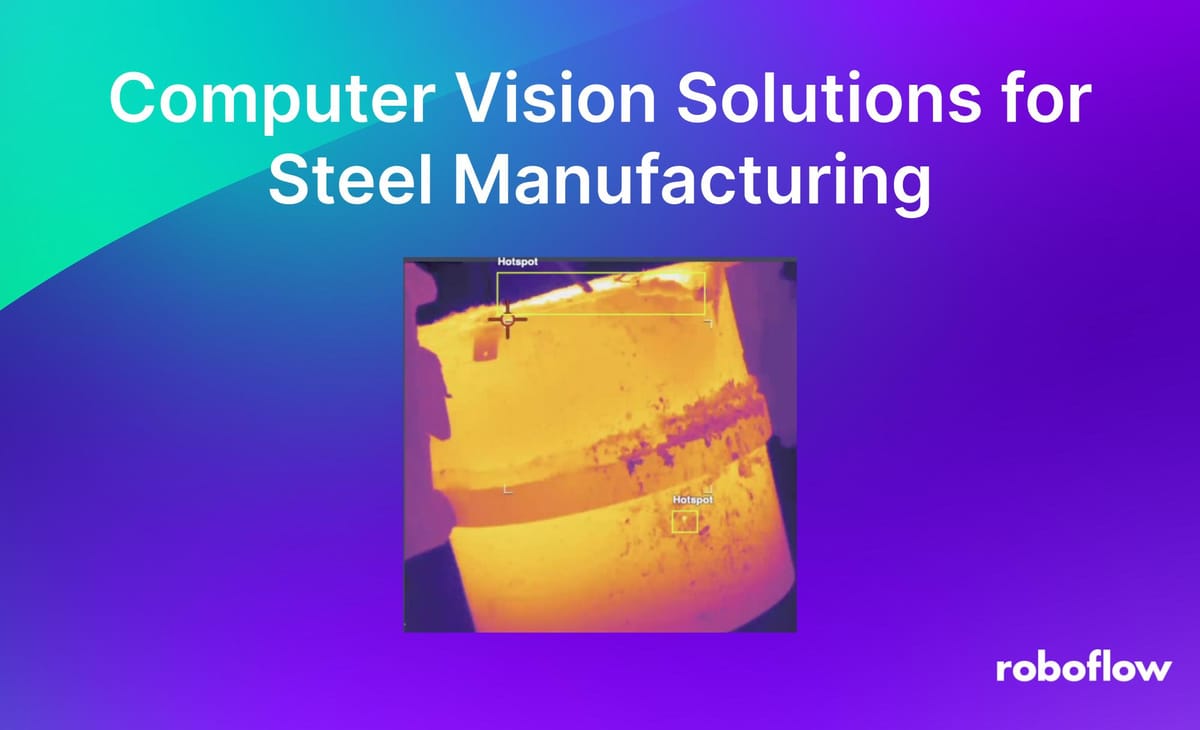
In the steel manufacturing industry, precision, safety, and efficiency are paramount. Computer vision offers innovative solutions to address these critical needs, and one such advancement is computer vision. Roboflow supports multiple Fortune 50 steel manufacturers to automate process flow.
This blog post explores how custom computer vision models support steel manufacturers, focusing on two key use cases: (1) steel ladle thermal hotspot detection and (2) coil defect detection.
Steel Ladle Thermal Hotspot Detection
In steel manufacturing, the ladle is a crucial component used to transport and pour molten steel. Maintaining the integrity of the ladle is essential to prevent accidents and ensure efficient operations. One of the significant risks is the development of thermal hotspots, which can lead to ladle failure and catastrophic spills of molten metal.
oboflow's computer vision technology can be deployed to continuously monitor the ladle for thermal anomalies. By integrating infrared cameras and advanced image processing algorithms, Roboflow's solution can detect hotspots in real-time. Here's how it works:
- Data Acquisition: Infrared cameras capture thermal images of the ladle's surface.
- Object Detection: Data is fed through a custom Roboflow object detection model detecting ladle hotspots and reading
- Alert System: When a thermal hotspot is detected, the system can trigger alerts for immediate action, preventing potential ladle failures.
With computer vision, you can enable:
- Improved Safety: Early detection of hotspots reduces the risk of accidents and enhances worker safety.
- Extended Equipment Life: Timely maintenance and repairs can be carried out before severe damage occurs, extending the lifespan of the ladle.
- Operational Efficiency: Minimizing unplanned downtime and interruptions ensures an efficient production process.
Here’s the model in action detecting hotspots on a FLIR thermal camera:
Coil Defect Detection
Steel coils are large, continuous rolls of steel that have been processed and formed into a coiled shape. Detecting defects and proper alignment in these coils early in the production process is vital to maintain product quality and reduce waste.
Roboflow's computer vision models inspect steel coils for the following:
- Automated Visual Inspection: Automatically detect surface scratches, dents, as well as alignment and warping for real-time andon alerts.
- Automated Inventory Tracing: Integrate with inventory management software, providing real-time updates on stock levels, locations, and movements of steel coils.
With computer vision, you can enable:
- Enhanced Quality Control: Automated and accurate defect detection ensures only high-quality WIP moves forward through production.
- Improved Traceability: Detailed records of each coil’s history, including production details and movement, enhance traceability and accountability.
- Increased Productivity: Automated inspection processes boost operational capacity and reduce labor hours spent on manual inspection, leading to higher throughput.
Here’s a coil counting model on Roboflow Universe (link).
How Do We Build in Roboflow?
You don’t need to be an expert in AI/ML, nor coding experience to build and deploy a custom computer vision model with Roboflow. Highlighting the three main tiers to building a computer vision model with Roboflow: (1) Data, (2) Models, and (3) Deployment.
Data Upload
Begin by uploading data (video or images) of the objects we are trying to detect ie Steel Coils.
Note: The model performance directly reflects the quality of the data. Good data in, good data out.
Labeling Data
Once the data is uploaded, the images must be labeled, to “teach” the AI model what to detect – these are our classes.
Roboflow offers a suite of labeling tools, like Smart Polygon tool to quickly segment classes. Here’s the demonstration, labeling steel coils:
Training
Once the dataset of labeled images is confirmed, a model version is then created and trained.
Roboflow offers training credits to users in order to expedite model training at the click of a button
Deployment
Since Roboflow is hardware agnostic, users are not tied down by any one hardware line. Users have the option to deploy via Roboflow API, Self-hosted API, or a dedicated Software Developer Kits (SDK), including a web browser or Apple iOS.
See what deployment best works for you at Roboflow.com/deploy!
Roboflow's computer vision solutions offer steel manufacturers powerful tools to enhance safety, improve product quality, and optimize efficiency. By leveraging advanced imaging technologies and machine learning, manufacturers can detect thermal hotspots in steel ladles and identify defects in steel coils with unprecedented accuracy and reliability.
Cite this Post
Use the following entry to cite this post in your research:
Daniel Bender. (Jun 28, 2024). Computer Vision Solutions for Steel Manufacturing with Roboflow. Roboflow Blog: https://blog.roboflow.com/steel-manufacturing-computer-vision/
